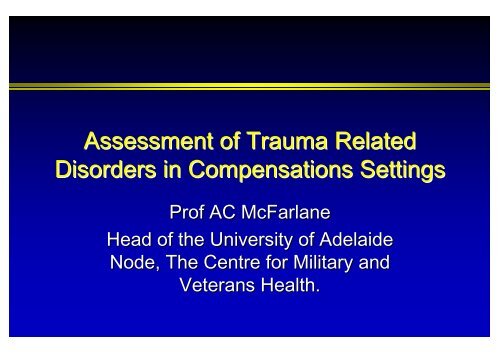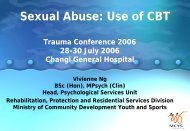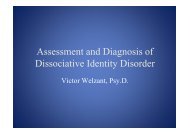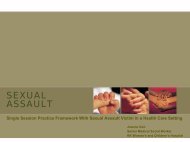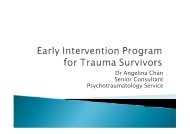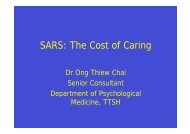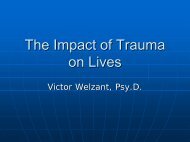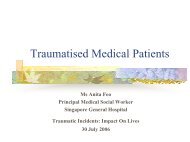Prof McFarlane
Prof McFarlane
Prof McFarlane
Create successful ePaper yourself
Turn your PDF publications into a flip-book with our unique Google optimized e-Paper software.
Assessment of Trauma Related<br />
Disorders in Compensations Settings<br />
<strong>Prof</strong> AC <strong>McFarlane</strong><br />
Head of the University of Adelaide<br />
Node, The Centre for Military and<br />
Veterans Health.
The Challenges<br />
What is an acceptable level of function for a<br />
disorder?<br />
Need for an acceptable standard of diagnosis<br />
Need for scientifically based decision making<br />
by claims managers<br />
Need to ensure implementation of evidence<br />
based treatment
Trauma in the Workplace<br />
<br />
Environments where<br />
trauma is a regular<br />
occurrence<br />
» Police<br />
» Fire<br />
» Ambulance<br />
» Banks<br />
» Hospitals<br />
» Prisons<br />
» Security companies<br />
» Military<br />
Environments where<br />
trauma is infrequent<br />
» Transport industry<br />
» Mining<br />
» Fishing<br />
» Agriculture<br />
» Heavy industry<br />
» Any workplace
What is a traumatic event?<br />
DSM IV definition is the benchmark<br />
The causal role is more generally<br />
accepted in the courts<br />
Less stigmatized than other causes<br />
Over use of the concept<br />
» Bullying<br />
» Teachers stress
Stressor Criterion for PTSD<br />
A: : The Stressor Criterion<br />
The person has been exposed to a traumatic event in which both ofo<br />
f the<br />
following were present:<br />
A1: The person experienced, witnessed, or was confronted with an event t or<br />
events that involved actual or threatened death or serious injury, or a<br />
threat to the physical integrity of self or others<br />
A2: The person's response involved intense fear, helplessness, or horror
Principles of Toxicology<br />
<br />
<br />
<br />
<br />
<br />
Level of exposure above which disease emerges<br />
Monitor individual exposures<br />
Mitigate the risk of exposure in the industry<br />
Have protection strategy for individuals<br />
Illness demands removal from the exposure to the<br />
toxin and put the individual in other roles
Risk (%) of Developing PTSD by Increasing Number of Traumas
Types of Stresses<br />
<br />
<br />
<br />
Hassles<br />
» Administrative<br />
» Controllability of workload<br />
Day to day life events<br />
» divorce<br />
» financial strain<br />
» Illness in family<br />
Traumatic events
Time 1 Time 2<br />
Event<br />
Event<br />
Symptoms<br />
Symptoms
Characteristics of Life Events<br />
<br />
<br />
<br />
<br />
Dependent v’sv<br />
s independent<br />
» Could this be a consequence of the individual’s s state of mind<br />
Attribution<br />
» Causal beliefs as determinants of behaviour<br />
Time window of effect<br />
» 6 month effect of day to day stresses<br />
» Prolonged window of effect with traumatic stresses<br />
Sensitization v’sv<br />
s hardening<br />
» Kindling v’sv<br />
s resilience
Occupational Stresses<br />
These can be caused by psychiatric<br />
disorder as well as being causal<br />
Supervisor relationships<br />
Group morale<br />
Administrative problems<br />
Workload<br />
Shift duties<br />
Interpersonal conflict
Epidemiology<br />
Prevalence of psychiatric disorders in<br />
the workplace<br />
» Remarkably little data<br />
» Military is the main source<br />
» Disaster affected populations
2007 ABS National Epidemiology Survey<br />
<br />
<br />
8,841 people - 60% response rate<br />
Over 16 years - life time and 12 month prevalence<br />
» 45% had a life time disorder<br />
» 20% 12 month prevalence<br />
26% of young adults (16-24)<br />
12 month prevalence<br />
Anxiety disorders 14.4%<br />
Affective disorder 6.2% - Depressive episode 4.1%<br />
Most common disorder<br />
- PTSD 4.6%<br />
Substance Use Disorder 5.1%<br />
» Alcohol harmful use 2.9%<br />
» Alcohol dependence 1.4%
The Life-Time Risk of Psychiatric<br />
Disorder<br />
Other Psychiatric<br />
Disorder<br />
Total Population<br />
PTSD<br />
Traumatic Event
History and Assessment<br />
Full employment history<br />
History of trauma exposure but not exclusively<br />
Detailed history of symptoms and longitudinal<br />
course<br />
Management of stress exposure and<br />
interventions by employer<br />
Other work place stresses and issues<br />
Past history of psychological treatment<br />
History of physical health complaints
Thresholds of reporting<br />
<br />
<br />
<br />
<br />
<br />
<br />
<br />
Psychologisers<br />
Somatisers<br />
Normalisers<br />
Problems of unitary thresholds of detection<br />
ECG recordings have very little relationship with<br />
reported palpitations<br />
Somatisers are unable to separate relevant and<br />
irrelevant<br />
Very little difference in 24 hour monitoring of arousal<br />
in those with anxiety disorders from controls
Critical Assessment Issues<br />
Definition of problem<br />
» Story of what happened v’sv<br />
s the reaction<br />
Importance of assessment of<br />
phenomenology<br />
Meaning to the individual<br />
» The present in the context of the past<br />
Somatization
Traumatic Event<br />
Nature of experience<br />
Anticipate likely triggers<br />
Meaning and self perception of<br />
response<br />
Behavioural reaction to event<br />
Response of employer<br />
Physical consequences
History of trauma<br />
Mechanics and proprioceptive features<br />
of experience<br />
Acute perceptions of interpersonal and<br />
physiological reactions<br />
Environmental interaction at the time<br />
Nature of the emotional reaction<br />
Acute treatment experience
DSM-IV Criteria for PTSD<br />
B: Re-experiencing<br />
experiencing<br />
The traumatic event is persistently re-experienced experienced in<br />
one (or more) of the following ways:<br />
1: Recurrent and intrusive distressing recollections of the event,<br />
including images, thoughts or perceptions<br />
2: Recurrent distressing dreams of the event<br />
3: Acting or feeling as if the traumatic event were recurring<br />
4: Intense psychological distress on exposure to reminders<br />
5: Physiological reactivity on reminders
Intrusion Phenomena<br />
Pain as a traumatic memory<br />
Kinaesthetic sensations<br />
Sounds and smells<br />
Images of the accident and injury<br />
The treatment environment<br />
Death or injury of others.
The Nature of Triggers<br />
Provoke the traumatic memory structure<br />
Real or symbolic similarity with some aspect<br />
of the traumatic event<br />
In a range of sensory dimensions<br />
May be interpersonal in nature<br />
Conscious awareness is often lacking<br />
Awareness minimised by avoidance
Avoidance and estrangement<br />
Avoidance of behaviours or places<br />
Avoidance of thoughts and feelings<br />
Psychogenic amnesia<br />
Social withdrawal<br />
Loss of sense of pleasure<br />
Emotional numbing<br />
Foreshortened sense of the future<br />
3 symptoms required
DSM-IV Criteria for PTSD<br />
C: Avoidance & Numbing (2 – “passive”)<br />
3: Inability to recall an important aspect of the trauma<br />
4: Markedly diminished interest or participation in<br />
significant activities<br />
5: Feeling of detachment or estrangement from others<br />
6: Restricted range of affect<br />
7: Sense of foreshortened future
Avoidance<br />
Emotional constriction as a method of<br />
coping<br />
Interferes with the development of goals<br />
in treatment<br />
Problem tolerating the worsening of<br />
symptoms during treatment<br />
Poor attendance - Self motivation and<br />
compliance
DSM-IV Criteria for PTSD<br />
D: Persistent Hyperarousal<br />
Persistent symptoms of increased arousal (not<br />
present before the trauma), as indicated by two<br />
(or more) of the following:<br />
1: Difficulty falling or staying asleep<br />
2: Irritability or outbursts of anger<br />
3: Difficulty concentrating<br />
4: Hypervigilance<br />
5: Exaggerated startle response
DSM-IV Criteria for PTSD<br />
E: Duration<br />
Duration of the disturbance (symptoms in Criteria B, C,<br />
and D) is more than 1 month<br />
F: Impairment<br />
The disturbance causes clinically significant distress or<br />
impairment in social, occupational, or other important<br />
areas of functioning
Indirect manifestations of Trauma<br />
Increased alcohol use<br />
Interpersonal and/or family conflict<br />
Social withdrawal<br />
Depression<br />
Somatic distress<br />
Performance deterioration<br />
Increased sick leave
Somatic distress<br />
Accounts for over one third of general<br />
practitioner and specialist referrals<br />
Multiple aetiologies -<br />
Seized upon by sub-specialists specialists rather<br />
than generalists
Saw doctor about physical health complaint<br />
PTSD No PTSD<br />
(n = 77) (n = 70)<br />
Respiratory 19% 4% 6.69 *<br />
Musculoskeletal 39% 22% 4.00 **<br />
Cardiovascular 14% 9% 0.52<br />
Gastrointestinal 13% 6% 1.06<br />
Dermatological 17% 9% 1.46<br />
Urological 1% 4% 0.16<br />
Headaches & funny turns 17% 9% 1.45<br />
* P
The issue of memory<br />
PTSD is the disorder most associated<br />
with pain<br />
Increased complaints of physical<br />
symptoms in many populations<br />
Importance of somatosensory memory<br />
<strong>McFarlane</strong> et al (2008) Psychosomatics
Distinct Syndromes<br />
Chronic fatigue<br />
Irritable bowel<br />
Multiple chemical sensitivities<br />
Fibromyalgia<br />
Post concussion syndrome<br />
Whiplash<br />
Post infectious fatigue
Headache<br />
Poor concentration<br />
Fatigue<br />
Muscle pain<br />
Impaired memory<br />
Unfreshing sleep<br />
Shared symptoms
Multiple Causes of Handicap<br />
Physical injury<br />
Social expectations<br />
Distress<br />
Disability & Handicap<br />
Psychological<br />
Disorder<br />
Personality
Objective Assessment<br />
Separation of the organic causes of<br />
symptoms<br />
Not a process of exclusion of the physical<br />
Both need to be assessed independently<br />
Often co-exist
Burden of Disease Associated with<br />
PTSD
Partial days out of role by disorder<br />
More of the PTSD group than expected had 8+<br />
partial days out of role, p < .0001
Days out of role by disorder<br />
More of the PTSD group than expected had 8+ days off, p <<br />
.0001
Burden of Disease in NCS<br />
In terms of impact, prevalence<br />
and financial burden on society,<br />
major depression and PTSD<br />
head the list of mental disorders<br />
Kessler, 2000.
Evidence based treatment in a<br />
compensation setting: Management<br />
issues<br />
<strong>Prof</strong> AC <strong>McFarlane</strong><br />
Head of the University of Adelaide<br />
Node, The Centre for Military and<br />
Veterans Health.
Trauma related services<br />
Disasters<br />
Mental Health Resources<br />
Specialized trauma<br />
Services<br />
Consultation and liaison<br />
services<br />
Individual Traumatic events<br />
Car Accidents<br />
Victims of Crime<br />
Military<br />
Rape victims<br />
Child abuse<br />
Torture Victims
What does epidemiology teach us?<br />
<br />
<br />
<br />
<br />
<br />
<br />
Traumatic events are far more common than was<br />
anticipated<br />
There will be an interaction between workplace and<br />
personal traumatic events<br />
PTSD is not the only consequence MDD and alcohol<br />
abuse<br />
There is a long delay between exposure and<br />
individuals presenting for treatment<br />
Disorder is the exception not the rule<br />
Repeated and prolonged trauma exposure is a critical<br />
determinant of risk
Critical Incorrect Misconceptions<br />
People who are ill will present for<br />
treatment<br />
People who are ill will be obvious to their<br />
supervisors<br />
All people who are ill have little<br />
motivation to work<br />
Traumatic stress is a created epidemic
Identification of Morbidity<br />
SUBCLINICAL<br />
UNKNOWN<br />
DISORDER<br />
KNOWN<br />
DISORDER<br />
WORKFORCE POPULATION
Workplace Mental Health Care<br />
<br />
<br />
<br />
<br />
<br />
Screening, treatment and telephone follow up<br />
Significant improvement<br />
Improved productivity, less absences, less training costs<br />
Cost/benefit established<br />
Problem of acceptance and take up<br />
<br />
Barriers in Australia<br />
» No employer based health insurance<br />
» EAP- some not evidence based<br />
» Under diagnosis by GP’s<br />
Wang et al, JAMA, 2007
Challenge for Employers<br />
Document work place exposures<br />
Record the exposures of individual<br />
employees<br />
Have a risk management strategy<br />
» Psychological first aid - not debriefing<br />
» Screening<br />
» Anticipated delayed onset<br />
» Workplace stress as a proxy indicator
Advising the Organization<br />
Good quality advice with expertise in<br />
traumatic stress<br />
Policy and procedures<br />
Implementation strategy<br />
Occupational health service with training<br />
Line manager training<br />
Audit workers compensation claims<br />
Background industrial tensions
Delay between onset of disease<br />
and presentation for treatment<br />
Replication of the NCS<br />
12 month prevalence<br />
» 3.6% PTSD<br />
» 6.7% MDD<br />
Mean delay in receiving treatment<br />
» PTSD 12 years<br />
» MDD<br />
8 years
Impact of Delayed Identification<br />
Further exposure<br />
Progressive hardwiring of neurobiology<br />
Decreased efficacy of treatments<br />
» Evidence is not clearly established<br />
Further workplace stress as a<br />
manifestation and aggravating factor
Advising about a case<br />
Ascertain the nature of the duties<br />
What alternative duties are available?<br />
Speak to supervisor if possible<br />
Create realistic expectations<br />
Manage issues raised about the<br />
employee - performance issues may be<br />
an indication of symptoms
Advising the Worker<br />
Going off work is not necessarily the<br />
best strategy but protect from further<br />
exposure until treatment is successful<br />
Explain symptoms and identify<br />
environmental triggers<br />
Importance of early treatment<br />
Separate the industrial and<br />
compensation issues
Issues for Health <strong>Prof</strong>essional<br />
Remove from further possibility of trauma<br />
exposure if the worker remains at work<br />
Thorough history and diagnosis<br />
Need to provide evidence based treatment -<br />
NHMRC guidelines<br />
Ensure that full range of treatments have<br />
been covered<br />
Assess residual disability and risks of further<br />
exposure
Screening in High Risk<br />
Environment<br />
<br />
<br />
<br />
<br />
<br />
<br />
Optimal timing - 120 days<br />
Need for appropriate measures<br />
» Not personality measures such as the MMPI used in<br />
selection<br />
Annual assessment<br />
Validation of cut offs against clinical interviews<br />
Follow up with clinical assessment<br />
Subclinical symptoms are an indicator of risk
Traumatic exposure<br />
PCL<br />
K 10<br />
Audit<br />
Measures
Screening after London Bombings<br />
<br />
<br />
<br />
<br />
<br />
<br />
Problems of getting access to population<br />
Defined high risk groups<br />
71% screened positive<br />
PTSD the predominant diagnosis<br />
Treatment given to 82 with large effect size<br />
More referrals from screening than GPs who had<br />
been contacted<br />
Brewin et al, 2008 Journal fo Traumatic Stress, 21 3-83
Identification of Morbidity<br />
SUBCLINICAL<br />
UNKNOWN<br />
DISORDER<br />
KNOWN<br />
DISORDER<br />
TOTAL WORKFORCE
TREATMENT
Public Health Perspective<br />
The possible interventions<br />
– Do not over-estimate estimate value of prevention<br />
Planning and coordination<br />
– Part of general health policy<br />
The identification of those at risk<br />
Need a mental health literacy program
Modeling of Trauma Impact<br />
Risk<br />
Factors
Modeling of Trauma Impact<br />
Risk<br />
Factors<br />
Exposure<br />
Severity &<br />
Losses
Modeling of Trauma Impact<br />
Risk<br />
Factors<br />
Exposure<br />
Severity &<br />
Losses<br />
Secondary<br />
Stressors
Treatment Issues<br />
<br />
<br />
<br />
<br />
Exposure treatment is more effective than supportive<br />
counselling<br />
The linking of the memory with the affect and creating a<br />
narrative is critical to treatment<br />
Implies that a specific treatment is required<br />
Medication assists psychotherapy
Therapy principles<br />
Identify content of flashbacks<br />
Focus exposure on these and on other moments of<br />
intense emotion (hotspots)<br />
Modulate arousal so that individual is fully aware<br />
and does not dissociate (graded exposure, 3rd<br />
person narratives, typing vs. writing)
Early Intervention in PTSD<br />
97 individuals with PTSD in initial<br />
months after MVA<br />
3 interventions, CBT, self help book and<br />
repeat assessment<br />
Outcome<br />
» CBT 11% PTSD<br />
» Booklet 61% PTSD<br />
» Follow up 51% PTSD<br />
» Ehlers et al, 2004
Breuer and Freud: Psychical mechanism of hysterical<br />
phenomena (1893)<br />
“...each individual hysterical symptom immediately and<br />
permanently disappeared when we had succeeded in<br />
bringing clearly to light the memory of the event by<br />
which it was provoked and in arousing its accompanying<br />
affect, and when the patient had described that event in<br />
the greatest possible detail and had put the affect into<br />
words.” (p 57)
Possible Improvements<br />
At the point of registration of a traumatic<br />
injury, a psychological screen should be<br />
administered<br />
Greater effort at maintaining in the<br />
workplace following traumatic events<br />
Referral to high quality multidisciplinary<br />
health service<br />
Matching activity to disability
Occupational Health Service<br />
Management responsibilities<br />
<br />
<br />
<br />
<br />
<br />
<br />
<br />
Advise about monitoring trauma exposure<br />
Assist identifying individuals at risk<br />
Advise about rotation in high risk groups<br />
Train supervisors<br />
Healthy life style and resilience programs<br />
Maintain relevant organisational knowledge base<br />
Monitor injury and sick leave patterns
<strong>Prof</strong> AC <strong>McFarlane</strong><br />
Centre of Military and Veterans Health<br />
The University of Adelaide<br />
122 Frome Street<br />
Adelaide<br />
South Australia<br />
Australia 5000<br />
Telephone 61 88303 5200<br />
Fax 61 88303 5368<br />
Email alexander.mcfarlane@adelaide.edu.au


